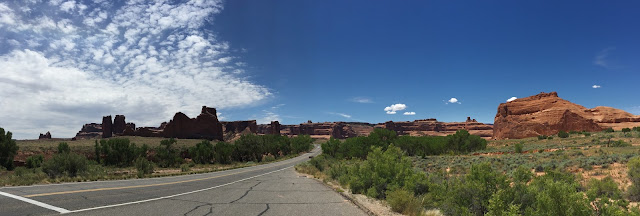 |
| Grand, indeed |
Grand Canyon, AZ. 8/3/2015: This must be the place. As some old comedian used to say, "There's no place quite like this place, so this must be the place." This is the Grand Canyon, one of the Wonders of the World. It is so grand it covers 1900 square miles, is 277 miles long (river miles), is one mile deep and up to 18 miles wide. It can be seen from space. That is one really grand canyon.
It fascinates me, mentally and emotionally, so I keep coming back as often as I can.
In round terms, the Grand Canyon is 2 billion years old..half the age of the Earth itself. It has great beauty, but it also has dignity. And the canyon has a voice..you hear it with your eyes. Listen and you will learn.
Sky so blue, shadows so deep.
-0-
Our day at the canyon was full of side stories. For instance,we encountered this Raven, who seemed to like having its picture taken.
We first saw Mr. Raven sitting on a stone wall at the edge of the canyon, so we pulled up near it. I thought I could get a picture, but I didn't want to do it from too far away, so I moved the car slowly until we were parked literally next to the bird. It never moved..in fact, it preened for the camera, turning its head left and right, up and down--ruffled its feathers a bit--but it never moved until another car drove in. Seeing the new group, the raven turned its back on us and marched up the wall to see what it could do for the next customer.
I've seen them do this before. I suspect they're just hoping for a goody from your lunch box, but you are told repeatedly not to feed the animals in the park. Obviously, somebody does feed them, because they keep coming back. It's very clear they are not afraid of people.
-0-
Whoa! That is a classic T-Model Ford, just like the one that a young Edsel Ford drove from Detroit to San Francisco in 1915 to prove the car was tough enough to do it. The country wasn't much on pavement in those days, so Edsel took dirt roads, cow paths and the easiest way across farm fields to get there. And he did.
Now, meet Jim Gallagher of North Carolina. He and his crew are doing the same thing.
Their Model T comes from Maryland, where it was tuned up for the trip, which began in Detroit, just like Edsel's foray. Ford Motors donated a 2015 Mustang to go along as escort, but naturally, nobody pays a lot of attention to the Mustang.
Jim says the only problem they've had so far is one flat tire.
Because the car isn't allowed on the Interstates, it is doing what Edsel did..back roads and farm fields. Jim says they've met a lot of great people along the way, including farmers who've opened gates to let them through and folks who just want to talk. He and his crew stopped today at the canyon as one of the major waypoints.
The T-Model is a muddy mess, but Jim told me that when he, as a representative of the Historic Vehicle Association, turns it over for display in San Francisco, it's going to stay "as is" so everybody can get a sense of what it did and how it did it.
It was like old times: I found myself doing an interview.
Jim's a great guy..and he's got one heckuvva car. Here are a couple of details you might like:
The catbird seat.
Elegant hood ornament.
The marker. Look for it.
-0-
Now, here's a factoid you might have missed: CCC (Civilian Conservation Corps) workers helped with construction projects at the park beginning in 1933. One of the many jobs was to string a telephone line from the south rim to the north rim. One of the poles still exists, planted just over the wall at the edge of the precipice near the El Tovar hotel. Some kinda feat!!
-0-
It was a wonderful day, but marching along with me can be wearisome, sometimes, so Jane always brings her crochet work. She took a break in a rocking chair on El Tovar's spacious front porch while I went off to the cliff-top Kolb studio.
There are worse ways to watch the passing parade. Jane took some of these pictures..but not that one.
-0-
As I said, I come here as often as I can. If you have read this blog before, you may remember that I have a favorite bench by the canyon.
It still is.
###
JS. 8/3/2015

























































